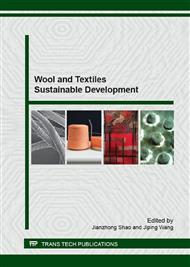[1]
Li Zhang. Tubular textile composite material and its application in pipeline repair technology , D. Tianjin: Tianjin Polytechnic University, (2006).
Google Scholar
[2]
Shujie Zhang. The research of tubular textile composites on pipeline rehabilitation , D. Tianjin: Tianjin Polytechnic University, (2007).
Google Scholar
[3]
Rui Wang, Li Zhang, Huan Wang, etc. The textile lining layer design of Pipeline trenchless textile lining repair technology, J. Journal of industrial textiles, 2007. 2, 10-13.
Google Scholar
[4]
Rui Wang, Shujie Zhang, Huan Wang, etc. The mechanical properties of the tubular textile composits on pipeline rehabilitation, J. Journal of textile journal, 2007 (6) : 70-74.
Google Scholar
[5]
Wei li, Haibo Wu. The effect on the properties of polyester needle-punched nonwoven fiber of acupuncture depth and quantitative, J. Journal of nonwovens, 2010 (01) : 25 - 27.
Google Scholar
[6]
Jianxiong Cheng. The research of the structure, properties and preparation technology of tubular nonwovens composite material, D. Tianjin: tianjin university of technology, (2009).
Google Scholar
[7]
Jianhui Guo. The research of the structure, properties and preparation technology of tubular nonwovens composite material, J. Journal of tianjin university of technology, (2011).
Google Scholar
[8]
Zhenxing Hao, Shujie Zhang, Rui Wang, etc. The strength structure design of the tubular textile composits on pipeline rehabilitation, J. Journal of industrial textiles, 2010 (6) : 11-16.
Google Scholar
[9]
CHIN W S, LEE D G. Development of the trenchless rehabilitation process for underground pipes based on RTM, J. Composite Structures, 2005, 68(3): 267-283.
DOI: 10.1016/j.compstruct.2004.03.019
Google Scholar
[10]
MA B, NAJAFI M. Development and applications of trenchless technology in China , J. Tunnelling and Underground Space Technology, 2008, 23(4): 476-480.
DOI: 10.1016/j.tust.2007.08.003
Google Scholar
[11]
GUO W, SOIBELMAN L, GARRETT JR. J H. Automated defect detection for sewer pipeline inspection and condition assessment, J. Automation in Con- struction, 2009, 18(5): 587-596.
DOI: 10.1016/j.autcon.2008.12.003
Google Scholar
[12]
Shujie Zhang, Rui Wang, Huan Wang. The design principle of the tubular textile composits strength on pipeline rehabilitation, J. Journal of composite materials, 2008, 25 (2) : 161-165.
Google Scholar
[13]
Chunwen Yan. The statistical analysis of trenchless industry in 2013, A. Proceedings of trenchless technology conference in 2014, C. (2014).
Google Scholar
[14]
Raja Nassar, Mahmoud Yousef. Analysis of creep failuretimes of cured in place pipe rehabilitation liners. Tunnelling and Underground Space Technology . (2002).
DOI: 10.1016/s0886-7798(01)00056-6
Google Scholar


